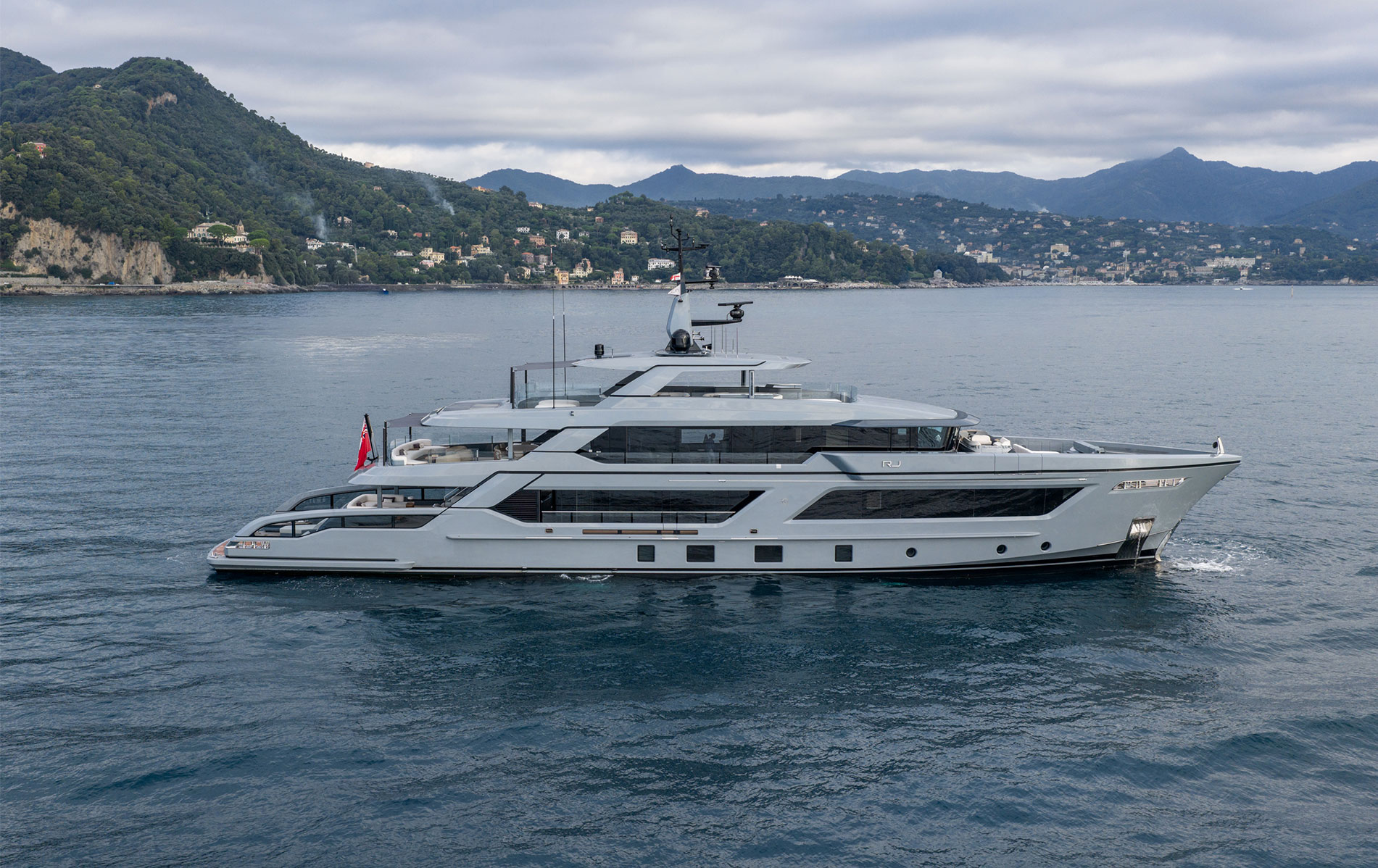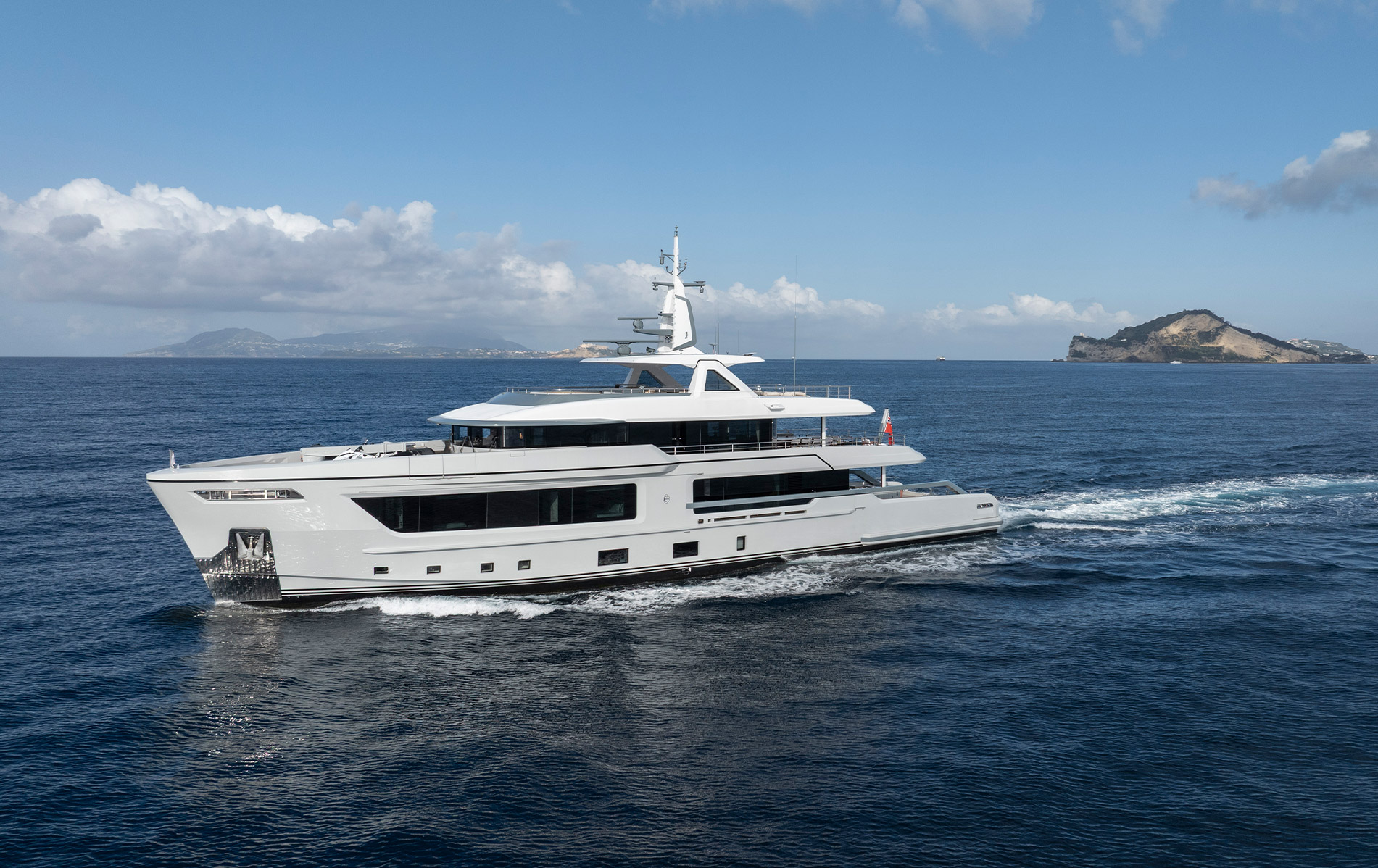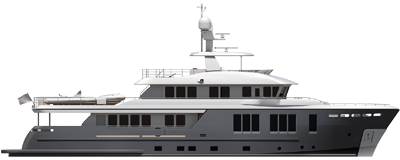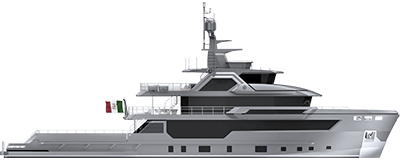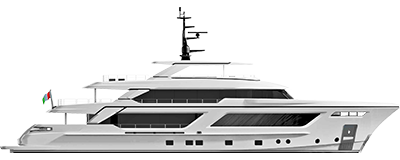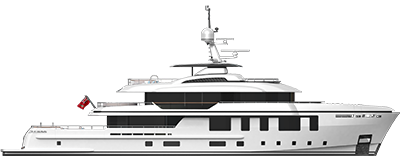Fearless
Beauty
Yachting Magazine dedicates its latest cover to Darwin Class 96': the sea trial by Michael Verdon.
The Darwin 96 is A go-anywhere, steel-hull passagemaker with a 6,000 nm range. The owner of Stella di Mare, the first Darwin 96 from Cantiere delle Marche (CDM), planned to spend several weeks aboard with his family after the yacht launched in April. Four months later and with just five days in port, he and his family have cruised 5,000 miles throughout the Mediterranean, from Croatia to Greece and Turkey, and then to Sicily, Sardinia and France. And this relatively new, upstart builder wouldn’t have it any other way. Launching a yacht-building business during the height of Europe’s economic crisis may not seem like a promising prospect, especially if your first offering is a niche product like an 86-foot expedition yacht. But for CDM, a start-up shipyard in Ancona, Italy, the decision to build its Darwin expedition series in 2010 has been a masterstroke. (The company’s principals have many years of experience constructing everything from tankers to cruise ships to pleasure craft.) So far, not only does CDM have a backlog of orders stretching into 2015, but it also has six models ranging from 82 to 136 feet. To ensure the quality of every vessel built, the yard does no more than four to five deliveries per year. It all started when CDM witnessed the growing popularity of expedition style yachts. Plenty of builders were making fiberglass boats that looked like expedition yachts, but few shipyards were building steelhull voyagers under 100 feet with transatlantic range and enough stowage, fuel and equipment to head out to sea for months at a time.
CDM’s first four owners have done just that. The first Darwin 86, Percheron, was an instant hit with her owner, who wanted a trawler-style vessel based on a traditional Mediterranean fishing boat but couldn’t find a shipyard to build it until CDM launched operations. Percheron hit the water in June 2012 and has put 12,000 nm beneath her hull, including a transatlantic crossing. Another 86 crossed the Atlantic this year, and a third Darwin owner has plans to make the same trip next year. The most striking thing about these owners is that they’d all owned 70-plus-foot planing yachts, so they were used to running hard for short distances. An extended cruise for them was a weekend on the hook in some Mediterranean port. “Two owners have told me that these boats have changed their whole lifestyles,” says Darwin series designer Sergio Cutolo. “I don’t think we’ve had a higher compliment.” Based on the success of its 86, CDM built a big sister, the Darwin 96. Yachting first saw Stella di Mare at her official launch at the Cannes boat show in September. Instead of looking ragged after four months at sea, the yacht was polished and fresh, with her rugged trawler profile looking like a freckle-face country cousin among the highly stylized, contemporary hulls on Superyacht Row.
But the Darwin 96, with her navy hull, superstructure pushed forward, ultrahigh bulwarks and steep bow, also looked like a boat that could handle herself in big water. CDM officials actually apologized that the Golfe de la Napoule and Mediterranean Sea weren’t rough enough to get a good sense of the hull’s potential. My two-hour run along the French Riviera coast in 3-foot seas offered a glimpse of why an owner might want to spend four months on board. Her no-nonsense exterior may look like a buttoned-down trawler, but the Darwin 96’s interior was closer to a spacious country house. It was clear, stepping into the main salon, that comfort was a priority. The main-deck salon, measuring 495 square feet with 7 feet of headroom, feels larger than one would expect, even on a 96-footer. The extra 10 feet that Stella di Mare has over her smaller siblings results in 2,465 square feet of interior space, which allowed Cutolo to add volume to important areas including the engine room, lazarette and VIP stateroom. Stella di Mare’s owner says the yard honored his “craziest” requests, including a climate-controlled wine cellar for 900 bottles from his Italian vineyard in a specially designed space under the VIP cabin. That might sound excessive to nonaficionados, but apart from that single feature, the interior was tasteful and subdued. Pierluigi Floris, the interior designer, used satin-finish natural elm for the floors and furniture and as accents on the white walls. The interior exudes a real sense of calm.
Travertine marble in the bathrooms and Bisazza mosaic in the showers add a luxe touch, but nothing felt over the top. Combined with the banks of windows in the hull and superstructure, those details created a light feel throughout the interior, even in the four belowdecks staterooms. (Three crew cabins are in the bow area, accessed by a separate entrance.) The yacht was designed for multigenerational family use, which explains the massive VIP suite for the owner’s parents. It is almost as large as the master stateroom. At one of Stella di Mare’s five port stops last summer, 22 people were on board, 11 of them children. Deck space is also one of the Darwin 96’s strong suits. There were a dozen people on the main cockpit deck for our sea trial, and it felt convivial rather than congested. The 635-square-foot space on the deck above was an open dance floor. And above that, the 540-square-foot skybridge is another social area, with an L-shaped lounge abaft the helm and another lounge directly behind, and still another four-person sun bed in the corner.
All the 96’s decks are teak, giving the exterior a yachtlike appearance rather than her looking like a dressed-up commercial outfit. Her fit and finish are superior — CDM does most of the stainless-steel work in-house, and it shows. Many side rails are 10 to 20 feet long, and they’re single railings rather than pieces cobbled together. The interior offers similar attention to detail with grain-matched wood, marine-grade stainless-steel door handles and a brushed-aluminum-accented galley complete with Miele appliances. Three freezers hold provisions for extended cruises, and the galley has a trash compactor/locker that keeps the garbage refrigerated to eliminate odors. The engine room is one of the most spacious and orderly I’ve seen in a long time. CDM knew the crew would likely have to perform maintenance while in transit. The working space around the yacht’s twin 965 bhp MTU diesels was excellent, while the two 50 kW Kohler generators had their own corners. Straight lines everywhere offer line-of-sight checks. The gleaming stainless-steel exhaust covers above the white diesels look cool, as do the stainless-steel fittings in the lazarette.
Of course, the robustness of build is a major differentiator among expedition-style yachts. The steel under Stella di Mare’s waterline is 2.5 times thicker than required by the Royal Institute of Naval Architects class standards, and the shipyard uses copper-nickel piping instead of plastic. An oil separator in the bilge filters the water before it’s discharged too. Stella di Mare also has a Techni Biocon system to treat gray and black water. The physiochemical process cleans and discharges wastewater that meets the most generally accepted standards for effluent. One benefit of this ecoconscious equipment is that the Darwin 96 can enter harbors that are off-limits to other yachts. When crossing oceans, though, it’s about range. The 430,000 pound Stella di Mare reached a top end of 12.9 knots at 2,090 rpm. At this speed, fuel flow was 95.5 gph. Drop her pace to 8.5 knots, and fuel burn freefalls to 10.5 gph. Push her back up to the optimum cruise speed of 10 knots at 1,350 rpm, and the boat sips 25 gph, giving her a 6,000 nm range. The pilothouse is the place to be, as I discovered during my sea trial. It features excellent visibility, a well-laid-out helm, a single leather helm seat, a small steering wheel, joysticks for the Rodriguez hydraulic bow and stern thrusters, and three easy-view electronics displays powered by Furuno. Wing stations on either side of the helm provide efficient lines of sight when maneuvering the 96 in tight quarters.
Looking down from here, you feel like you’re master of the universe. Stella di Mare’s owner loves the pilothouse too, judging from the large window that opens to the aft bridge-deck salon. “He enjoys being involved with the operations,” says Cutolo. “He will stay in this pilothouse for hours at a time.” As proof, after the Cannes boat show the owner and his family got right back on Stella di Mare and headed south for another monthlong at-sea adventure. And why not?


